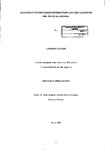Analysis of water masses distribution and circulation in the White Sea, Russia
| dc.contributor.author | Latché, Laurent | |
| dc.contributor.other | Faculty of Science and Engineering | en_US |
| dc.date.accessioned | 2011-09-23T13:51:27Z | |
| dc.date.accessioned | 2013-09-17T12:26:34Z | |
| dc.date.available | 2011-09-23T13:51:27Z | |
| dc.date.available | 2013-09-17T12:26:34Z | |
| dc.date.issued | 2004 | |
| dc.identifier | Not available | en_US |
| dc.identifier.uri | http://hdl.handle.net/10026.1/635 | |
| dc.description | Access to the full-text thesis is no longer available at the author's request, due to 3rd party copyright restrictions. Access removed on 28.11.2016 by CS (TIS). | |
| dc.description | Metadata merged with duplicate record (http://hdl.handle.net/10026.1/1805) on 20.12.2016 by CS (TIS). | |
| dc.description.abstract |
The White Sea is a semi-enclosed sea, which consists of several bays and estuaries connected to the open ocean through the narrow and shallow Gorlo Strait. Several studies have been carried out in the region during the last decade in order to investigate the potential threat of anthropogenic pollutants. However, the temporal and spatial resolution of such experiments has been inadequate to resolve issues such as the dispersion and propagation of environmentally hazardous substances. The present investigation uses in-situ measurements of temperature and salinity gathered at high spatio-temporal resolution for the first time, as part of the INTAS project "Mesoscale physical and biogeochernical processes in coastal waters of the Russian Arctic" and of a number of Russian national and EU research projects. The study focuses on the formation, evolution and spatial distribution of fine-scale thennohaline structures. The mixing processes were thoroughly studied in the southwest area of the Gorlo Strait, where present water masses have an important contribution in the dynamics of the White Sea including water-exchange and deep-water renewal. Satellite images were used to estimate the mesoscale circulation and the contribution of freshwater inputs to the formation and distribution of the water mass structure. Smaller scale mixing processes were also investigated using a statistical method of fine structure - inhomo gene ity analysis in order to assess the intensities of the diapycnal and isopycnal modes of small-scale mixing. The results showed i) the intrusion of mixed layers into the White Sea initially formed in the Gorlo area due to tidal mixing of the saline Barents Sea waters and the White Sea waters. The mixed layers were traced across the whole section, in the vicinity of an active boundary layer in a form of a domed structure, which separates from stagnant deep-water masses of the White Sea. ii) The formation of shelf-edge dense water was revealed in Kandalaksha Bay suggesting cascading phenomena. iii) A detailed study of the mixing processes in Gorlo revealed four interacting water masses: the Gorlo Strait Water (GSW), the White Sea Surface Water (WSSW), the Dvina Bay Water, and the White Sea Intermediate Water. Mesoscale "lens" of WSSW was observed in the nearsurface layer associated with a thermal front, which resulted in the formation of an intrusion of the GSW into the White Sea Basin, facilitated by the Terskii Coastal Current and the cyclonic Dvina Bay gyre. iv) The spatial distribution of temperature and salinity fluctuations within the water masses revealed the intensity of mixing and demonstrated the thermohaline transformation of the Gorlo Strait Waters during its mesoscale displacement at the intermediate depths across the northern Part of the White Sea. The findings of this study therefore provide a better understanding of the deep water renewal mechanisms in the White Sea. The classical concepts suggest that the saline waters of the Barents Sea enter the White Sea and sink at the entrance carrying with them all potential pollutants. The present study supports the hypothesis that the Barents Sea water is transformed at the Gorlo Strait and subsequently is propagated in the form of mixed layers across the White Sea until they reach the shelf of Kandalaksha Bay, where they finally sink. | en_US |
| dc.language.iso | en | en_US |
| dc.publisher | University of Plymouth | en_US |
| dc.title | Analysis of water masses distribution and circulation in the White Sea, Russia | en_US |
| dc.type | Thesis | |
| plymouth.version | Full version | |
| dc.identifier.doi | http://dx.doi.org/10.24382/4934 |
Files in this item
This item appears in the following Collection(s)
-
01 Research Theses Main Collection
Research Theses Main



